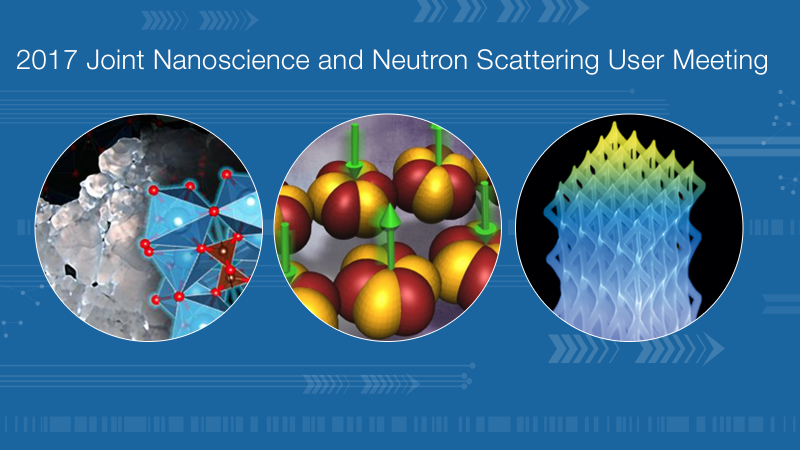An inclusive meeting for the neutron and nanoscience communities will enrich user experience at the world’s leading neutron scattering facilities in Oak Ridge, Tennessee.
In August, users of the Spallation Neutron Source (SNS) and High-Flux Isotope Reactor (HFIR) at Oak Ridge National Laboratory (ORNL) will convene for the annual meeting of the SNS-HFIR User Group, known as “SHUG.” This year’s meeting, held jointly with the Center for Nanophase Materials Sciences (CNMS), aims to “form connections between the neutron and nanoscience communities and invigorate users of ORNL’s neutron scattering facilities with fresh perspectives,” said Kate Ross, chair of SHUG’s executive committee.
SHUG’s executive committee helped to organize the 2017 Joint Nanoscience and Neutron Scattering User Meeting, which will take place August 1–2, 2017, at ORNL, with additional workshops and tutorials held July 31 and August 3–4. Registration is open through July 17.
Both oral and poster presentations will be selected from submitted abstracts, giving participants broad opportunities to contribute during the 2-day meeting. The deadline for submitting an abstract is June 7.
“Our goal in bringing these two user bases together is to inspire new ideas and collaborative opportunities for research at user facilities shared across neutron and nanoscience disciplines,” Ross emphasized.
As a user group, SHUG includes everyone who has ever used ORNL’s neutron scattering facilities, but the upcoming meeting is designed to engage experienced as well as prospective users. Researchers and students interested in becoming future users are encouraged to participate.
“This is a welcoming venue for graduate students and postdocs to present their work. We are a friendly community, and we have organized an inclusive meeting that will benefit new researchers with an opportunity to share results and get feedback from the community,” said Ross.
The conference will also benefit experienced users with exposure to other users’ perspectives. “The joint meeting gives experienced users the chance to come and talk to other people who use these facilities, from their own and other disciplines, and share ideas about how to make the facilities even better,” said Ross. “This is a rare opportunity for cross-disciplinary pollination of ideas,” she added.
The Joint User Meeting is designed to bring the user community together and provide a forum for users to not only share new results, but also express common interests and concerns to facility management, which will shape future capabilities and best practices. SHUG’s executive committee “forms a valuable link between users and facility management,” says Ross.
Established as external advisory committees and advocates for users, both SHUG and the CNMS User Group provide important avenues for two-way communication between facility management and the users and give a unified voice to group recommendations.
“User feedback is an essential part of this meeting,” said ORNL’s Jennifer Niedziela, who serves as secretary on SHUG’s executive committee. “We are bringing together staff and the user population to celebrate scientific successes, have wide-ranging discussions on how to improve the experience for future users, and identify new areas for research and development,” she elaborated.
The Joint User Meeting targets all levels of user experience with an expansive program of events. The main meeting, on August 1 and 2, features plenary sessions and a variety of invited and contributed talks on wide-ranging topics. The plenary sessions will bring both the CNMS and SHUG users together in the same room for crosscutting talks, says Ross. “We’ve taken great effort to select speakers who would be able to bridge those communities and highlight science that has benefited or could benefit from the use of their respective facilities.”
Users from both the neutron and nanoscience communities are encouraged to attend the town hall meeting on August 1 and panel discussions on August 2, which will provide open forums to address user questions and concerns. Additional meeting activities include poster sessions, a reception at the Shull Wollan Center, and facility tours.
Workshops preceding and following the main meeting days will also cross the boundary between neutron sciences and nanoscience. Some are more hands-on and geared toward inexperienced users, such as Sample Environment and You: How to Prepare for Your Experiment. Others focus on generating interest in emerging techniques like Polarized Neutron Capabilities at ORNL. A recent push to incorporate high-performance computing (HPC) into both the neutron and nanoscience fields will be explored in High-Performance Computing Resources for Neutron and Nano Users.
The SHUG Award for Excellence in Beamline Science is a featured highlight of the meeting that allows users to show appreciation to the exceptional beamline scientists at SNS and HFIR. The award recognizes the tremendous effort and expertise of the instrument scientists in advancing research, developing instrumentation, and supporting the user community. As Ross expressed, “There is a sense among users that they owe a lot to the beamline scientists, and they want to have a way to recognize those scientists who have gone above and beyond in helping them with their experiments.”
Users can nominate a beamline scientist, through June 30. Recipients will be honored at the Joint User Meeting.
For more information on the Joint User Meeting and a detailed agenda, visit the website at https://conference.sns.gov/event/81/.
CNMS, SNS, and HFIR are national user facilities supported by the US Department of Energy Office of Science, the single largest supporter of basic research in the United States, working to address some of the most pressing challenges of our time. For more information, please visit https://science.energy.gov/.—by Ashley Huff





